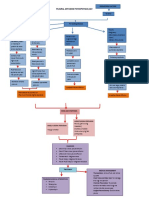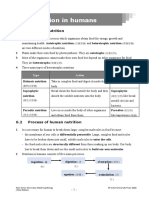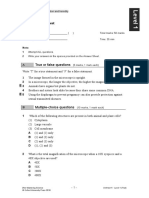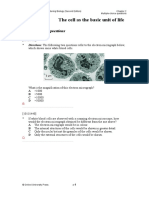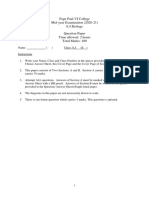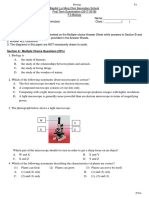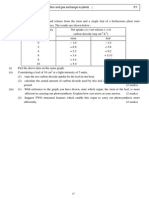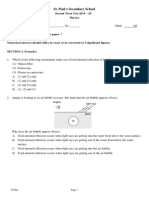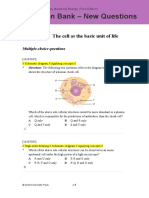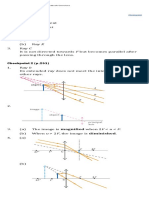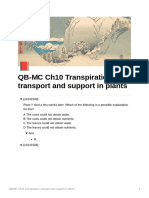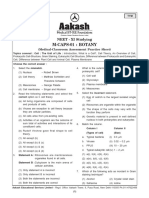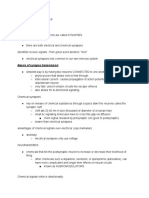Answers To Exam Practice: Chapter 3 Cellular Organization
Answers To Exam Practice: Chapter 3 Cellular Organization
Uploaded by
an ChiCopyright:
Available Formats
Answers To Exam Practice: Chapter 3 Cellular Organization
Answers To Exam Practice: Chapter 3 Cellular Organization
Uploaded by
an ChiOriginal Title
Copyright
Available Formats
Share this document
Did you find this document useful?
Is this content inappropriate?
Copyright:
Available Formats
Answers To Exam Practice: Chapter 3 Cellular Organization
Answers To Exam Practice: Chapter 3 Cellular Organization
Uploaded by
an ChiCopyright:
Available Formats
HKDSE BIOLOGY: Connecting Concepts Book 1A
Answers to Exam practice
Answers to Exam practice
Chapter 3 Cellular organization
Multiple-choice questions (p.3-36)
1. C
2. A
The nucleus is the most distinct part of the cell that can be observed with a light microscope.
Endoplasmic reticulum, ribosomes and mitochondria cannot be observed with a light
microscope at ×400 magnification.
3. A
4. D
5. B
Among the four options, chloroplasts are the bigger organelles. They contain the green
pigment chlorophyll which makes them easily observed.
6. C
In humans, red blood cells do not have a nucleus.
7. B
8. D
Muscle cells have a high density of mitochondria to fulfil their energy demand.
9. B
Insulin is protein in nature. Cells that secrete proteins have a high density of rough
endoplasmic reticulum.
10. A
Red blood cells are specialized for oxygen transport. They lack many organelles such as the
nucleus, endoplasmic reticulum and mitochondria.
11. B
12. A
Similar cells group together to form a tissue. They work together to perform one or more
particular functions.
© Aristo Educational Press Ltd. 1
HKDSE BIOLOGY: Connecting Concepts Book 1A
Answers to Exam practice
Short questions (p.3-38)
13. (a) Adjust the slide until cell X is at the centre of the field of view. (1)
(b) Adjust the condenser, iris diaphragm and mirror to increase the illumination of the
slide. (1)
Slowly turn the fine adjustment knob until the image becomes sharp. (1)
14. HKALE Biology 2011 Paper 1 Q3(a)–(b)
15. (a) (i) Cell B has a cell wall / a large vacuole. (1)
(ii) Cell C does not have a true nucleus. / Its DNA lies free in the cytoplasm. (1)
(b) 0.034 ÷ (2 × 10-6) (1)
= 17000X (1)
16. (a) A: cytoplasm (1)
B: cell membrane (1)
(b) (i)
Part of algal cell Function
nucleus controls activities of the cell /
contains genetic materials (or DNA or nucleic acids)
chloroplast photosynthesis
cell wall gives shape to plant cells /
prevents plant cells from bursting when water enters the cells
(1 mark for each correct blank, 3)
(ii) I: chloroplast / cell wall (1)
II: nucleus / chloroplast (1)
© Aristo Educational Press Ltd. 2
HKDSE BIOLOGY: Connecting Concepts Book 1A
Answers to Exam practice
17.
Feature Plant cells Animal cells Bacterial cells
Nuclear membrane ✓ ✓
Ribosomes ✓ ✓ ✓
Mitochondria ✓ ✓
Chloroplasts ✓
Cellulose cell wall ✓
(1 mark for each correct row, 5)
Structured questions (p.3-41)
18. (a) (i) It can be rotated to bring the suitable objective into position. (1)
(ii) It regulates the amount of light passing through the condenser. (1)
(iii) It reflects light to the slide from a light source. (1)
(b)
Eyepiece lens magnification Objective lens magnification Total magnification
5X 10X 50X
5X 40X 200X
10X 40X 400X
(1 mark for each correct blank, 3)
(c) Specimens observed with an electron microscope must be completely dehydrated and
chemically treated. (1)
This would kill the Paramecium. (1)
(d) To make the surface flat. / To prevent the specimen from drying up. / To prevent the
objective lens from touching the specimen. (1)
19. (a) (i) A: nucleus (1)
It contains the genetic material DNA which controls all activities of the cell. (1)
B: cytoplasm (1)
It holds all the organelles in a cell / provides a site for chemical reactions to take
place. (1)
(ii) Clear labelling lines pointing to cell membranes (1)
The cell membrane controls the movement of substances into and out of the cell. (1)
(b) Cell X is surrounded by a cell wall while cell Y is not. (1)
Cell X contains chloroplasts while cell Y does not. (1)
© Aristo Educational Press Ltd. 3
HKDSE BIOLOGY: Connecting Concepts Book 1A
Answers to Exam practice
20. (a) (i) A contains genetic material (or DNA or nucleic acids). (1)
B produces ribosomes. (1)
(ii) C: nuclear pore (1)
D: nuclear membrane (1)
E: ribosomes (1)
(b) (i) mitochondria (1)
They are the sites of aerobic respiration / ATP synthesis. (1)
(ii) One is a longitudinal section and the other is a transverse (cross) section. (1)
(c) Length of scale bar = 49/50 mm (1)
= 49 000/50 000 μm (1)
49 000/50 000 ÷ 8 = 6125/6250 (1)
21. (a) (i) A: mitochondrion (1)
B: ribosomes (1)
C: nucleus / nuclear membrane (1)
D: smooth endoplasmic reticulum (1)
(ii) B (1)
(iii) rough endoplasmic reticulum (1)
It is responsible for the synthesis and transport of proteins. (1)
(b) The mitochondria, ribosomes and nuclear envelope are visible in the diagram. These
structures are too small to be observed with a light microscope. (1)
22. (a) Length of the cell = 66 mm = 66000 μm (1)
66000 ÷ 3.5 = 18857 (1)
(b) (i) B (1)
(ii) C (1)
(iii) F (1)
(iv) D (1)
(c) nucleus / endoplasmic reticulum / mitochondrion (Any two, 2)
© Aristo Educational Press Ltd. 4
HKDSE BIOLOGY: Connecting Concepts Book 1A
Answers to Exam practice
23. (a) Drawing showing that the nuclear membrane is a double-membrane. (1)
The mitochondrion has a smooth outer membrane and a highly folded inner
membrane. (1)
Correct labels (1)
(b) (i) The cell wall supports and gives shape to the plant cell. (1)
(ii) The palisade mesophyll is less active in metabolism / requires less energy than the
epithelial cell of the thyroid gland. (1)
(c) (i) An organ consists of various tissues / types of cells while a tissue consists of one
type of cells only. (1)
(ii) Both tissues and organs are made up of cells. (1)
Essays (p.3-44)
24. • Light microscopes and electron microscopes with increased magnification and resolution
have been developed. (2)
Microscopes enable us to gain understanding of:
• cellular structures (1)
• tissue structure, e.g. histology of digestive system related to function, muscle structure,
kidney tubules, leaf structure (1)
• life processes, e.g. cell division, fertilization, capillary circulation (1)
• organisms as a whole and their classification, e.g. bacteria and viruses, taxonomic
differences in small organisms (1)
• other uses, e.g. understanding effects of disease / cancer, opportunities to improve or alter
organisms (1)
Communication (3)
© Aristo Educational Press Ltd. 5
HKDSE BIOLOGY: Connecting Concepts Book 1A
Answers to Exam practice
25. Similarities: (Max. 4)
• both possess a cell membrane / cytoplasm (1)
• their cell membranes are composed of phospholipids and proteins (fluid mosaic structure)
(1)
• both possess ribosomes (1)
• both possess DNA (1)
• both may contain glycogen (1)
Differences: (Max. 4)
• bacterial cells are much smaller (up to 10 μm) than animal cells (up to 100 μm) (1)
• a cell wall surrounds a bacterial cell, but not an animal cell (1)
• bacterial cells may have a capsule, while animal cells do not (1)
• the cell membrane of an animal cell contains cholesterol (absent in bacterial cell
membrane) (1)
• ribosomes in a bacterial cell are smaller than those in an animal cell (1)
• DNA linear in an animal cell while bacterial DNA is circular (1)
• DNA molecules are associated with proteins in animal chromosomes while bacterial DNA
lacks protein (is naked) (1)
• bacterial cells may contain plasmids, while animal cells do not (1)
• genetic material is enclosed in a nuclear membrane in animal cells, while genetic material
lies free in the cytoplasm of bacterial cells (1)
• bacterial cells contain no membrane-bound organelles, while animal cells do (e.g.
mitochondria, endoplasmic reticulum, lysosomes) (1)
© Aristo Educational Press Ltd. 6
You might also like
- 2006 - AIA - 2006guidelines For Healthcare Facilities PDFDocument347 pages2006 - AIA - 2006guidelines For Healthcare Facilities PDFAnonymous QqLPbyG5q100% (1)
- Pleurl Effusion Pathophysiology DiagramDocument2 pagesPleurl Effusion Pathophysiology DiagramAkiraMamo75% (4)
- Hkdse English Marking GuidelinesDocument4 pagesHkdse English Marking GuidelinesYING YUNo ratings yet
- S2 Eng 1 ST TermDocument63 pagesS2 Eng 1 ST Termapi-3796981100% (1)
- Rev Notes Ch06 eDocument9 pagesRev Notes Ch06 eCHIU KEUNG OFFICIAL PRONo ratings yet
- Janda Workshop 14hrDocument5 pagesJanda Workshop 14hrIgnacio De La Fuente100% (1)
- TMJ and Temporomandibular Joint Disorder: Dr. Soukaina RyalatDocument47 pagesTMJ and Temporomandibular Joint Disorder: Dr. Soukaina RyalatJohan Edward Franklin Marpaung100% (1)
- Answers To Exam Practice: Chapter 6 Food and HumansDocument5 pagesAnswers To Exam Practice: Chapter 6 Food and Humansan ChiNo ratings yet
- CH 1 Introducing BiologyDocument7 pagesCH 1 Introducing BiologyHa YeungNo ratings yet
- 2020 Form 5 Biology Mock Exam: A Saliva Secretion Is An Involuntary Action Controlled by U (Medulla)Document22 pages2020 Form 5 Biology Mock Exam: A Saliva Secretion Is An Involuntary Action Controlled by U (Medulla)UniversityJCNo ratings yet
- Nms Utest04 L1 Trial eDocument10 pagesNms Utest04 L1 Trial eHugo CheungNo ratings yet
- Suggested Answers To Exercise And: CH 11 Cell Cycle and DivisionDocument3 pagesSuggested Answers To Exercise And: CH 11 Cell Cycle and DivisionHarry LeungNo ratings yet
- Answers To 2017-2018 F3-CHEM Final Examination: Section A: Multiple ChoicesDocument13 pagesAnswers To 2017-2018 F3-CHEM Final Examination: Section A: Multiple Choicesjonas hoNo ratings yet
- Suggested Answers To Exercise, Reading To Learn and Cross-Topic ExerciseDocument23 pagesSuggested Answers To Exercise, Reading To Learn and Cross-Topic ExerciseBernardNo ratings yet
- BioA4 09. Nutrition and Gas Exchange in PlantDocument8 pagesBioA4 09. Nutrition and Gas Exchange in Plantthanks btNo ratings yet
- 2000-11 & 2012 Hkcee + Al LQDocument180 pages2000-11 & 2012 Hkcee + Al LQArthur ChoiNo ratings yet
- Chapter 1: Temperature and Thermometers: Physics Notes Heat and GasDocument3 pagesChapter 1: Temperature and Thermometers: Physics Notes Heat and GasWong Chun LamNo ratings yet
- Leapotswe International School: Cambridge IGCSEDocument16 pagesLeapotswe International School: Cambridge IGCSEShepherd W NgwenyaNo ratings yet
- LQ - 03 Cell Activity and OrganizationDocument40 pagesLQ - 03 Cell Activity and Organizationapi-3822784100% (2)
- Paper 1B (ENG) Question-Answer Book PDFDocument16 pagesPaper 1B (ENG) Question-Answer Book PDFsdcsNo ratings yet
- bk2 - ch17 - Sug Ans - eDocument3 pagesbk2 - ch17 - Sug Ans - enonameNo ratings yet
- The Cell As The Basic Unit of Life: Multiple-Choice QuestionsDocument67 pagesThe Cell As The Basic Unit of Life: Multiple-Choice QuestionsZ s2021 4C Ma Ka Ki Margaret 4C16No ratings yet
- 2 Supplementary Exercise Microscopic World I (Question)Document147 pages2 Supplementary Exercise Microscopic World I (Question)RyanNo ratings yet
- Scicent Quiz U7-3 Final eDocument3 pagesScicent Quiz U7-3 Final ephoebeqiliangNo ratings yet
- Question Bank 1A 1B 2 - New QuestionDocument58 pagesQuestion Bank 1A 1B 2 - New Questionteresa tsoiNo ratings yet
- BioA4 10. Transpiration Transport and Support in PlantDocument9 pagesBioA4 10. Transpiration Transport and Support in Plantthanks btNo ratings yet
- S4 Biology Section A and Section B Mid-Year Exam 202021Document20 pagesS4 Biology Section A and Section B Mid-Year Exam 202021(4A19 2122) SIT HEI TINGNo ratings yet
- Macro Mock P2 ENGDocument8 pagesMacro Mock P2 ENGtitle subNo ratings yet
- Hkdse Chemistry - A Modern View: (Second Edition) (Reprinted With Minor Amendments 2019)Document25 pagesHkdse Chemistry - A Modern View: (Second Edition) (Reprinted With Minor Amendments 2019)Tat LNo ratings yet
- New Senior Secondary Physics at Work (Second Edition)Document10 pagesNew Senior Secondary Physics at Work (Second Edition)Jeffrey YuetNo ratings yet
- Nssbio3e Sb1a Ch02 eDocument44 pagesNssbio3e Sb1a Ch02 emyaleung1221No ratings yet
- DSE Biology S.4 Exercise On (Ch.7) Nutrition in Human 1 (2024DSE)Document5 pagesDSE Biology S.4 Exercise On (Ch.7) Nutrition in Human 1 (2024DSE)冰雪樱恋No ratings yet
- 1718 F3 Bio 1 ST Term QDocument10 pages1718 F3 Bio 1 ST Term QSamson YauNo ratings yet
- Hkcee Biology - 4.1 Nutrition and Gas Exchange in Plants - P.1Document5 pagesHkcee Biology - 4.1 Nutrition and Gas Exchange in Plants - P.1irisyyy27No ratings yet
- F3 Phy Test 2 19-20Document5 pagesF3 Phy Test 2 19-20Carina WongNo ratings yet
- Msci Lssws02 eDocument9 pagesMsci Lssws02 efishyueNo ratings yet
- DSE Revision-S4 Term2aDocument15 pagesDSE Revision-S4 Term2atiffanyNo ratings yet
- A4 QB-MC Ch08 Transport in HumansDocument23 pagesA4 QB-MC Ch08 Transport in HumansReg ChooNo ratings yet
- HKCEE Biology 1991-1ansDocument15 pagesHKCEE Biology 1991-1ansPinky PinkyNo ratings yet
- Mock Bio Set8 eDocument58 pagesMock Bio Set8 ekenchan0810.kcNo ratings yet
- Transport in Humans: 8.1 The Human Transport SystemDocument11 pagesTransport in Humans: 8.1 The Human Transport SystemPhylliscccNo ratings yet
- Biology HKDSEDocument19 pagesBiology HKDSERoy SzeNo ratings yet
- Po Leung Kuk No.1 W.H.Cheung College Yearly Examination (2021-2022) FORM 6 CHEMISTRY PAPER 2 Suggested AnswersDocument4 pagesPo Leung Kuk No.1 W.H.Cheung College Yearly Examination (2021-2022) FORM 6 CHEMISTRY PAPER 2 Suggested AnswersChun Kit LauNo ratings yet
- Chem 12 (2nd) PDFDocument36 pagesChem 12 (2nd) PDFRyan100% (1)
- NSSBIO3E - QB Update - 1A - eDocument42 pagesNSSBIO3E - QB Update - 1A - ekatie yuNo ratings yet
- IJSO Ex DSE Bio Disease MCDocument3 pagesIJSO Ex DSE Bio Disease MC葡萄蘿蔔No ratings yet
- Unit 9 Assignment BookDocument28 pagesUnit 9 Assignment BookXenability0% (1)
- BioTextbookCh1 10Document312 pagesBioTextbookCh1 10Tafadzwa Mombeyarara100% (1)
- Reading Mock TestDocument11 pagesReading Mock Testbeyond belief100% (1)
- P S CL K Ca: F3 First Term RevisionDocument6 pagesP S CL K Ca: F3 First Term Revisionjonas hoNo ratings yet
- 19 Exercise Solutions - eDocument24 pages19 Exercise Solutions - eyuki100% (1)
- Evolution II: From Short-Necked To Long-NeckedDocument32 pagesEvolution II: From Short-Necked To Long-NeckedBernardNo ratings yet
- Chapter 14 SQDocument6 pagesChapter 14 SQ008 proartNo ratings yet
- NSSBIO3E SB4 Ch27 eDocument40 pagesNSSBIO3E SB4 Ch27 eBernardNo ratings yet
- Nms Utest04 L2 Trial eDocument11 pagesNms Utest04 L2 Trial eHugo CheungNo ratings yet
- Chem MC Content (1) MergedDocument171 pagesChem MC Content (1) MergedjlkdinhkNo ratings yet
- New Senior Secondary MASTERING BIOLOGY OXFORD Mock - Bio - Set6 - e - AnsDocument7 pagesNew Senior Secondary MASTERING BIOLOGY OXFORD Mock - Bio - Set6 - e - AnsChun Kit LauNo ratings yet
- A4 QB-MC Ch10 Transpiration Transport and Support in PlantsDocument31 pagesA4 QB-MC Ch10 Transpiration Transport and Support in PlantsReg ChooNo ratings yet
- M-Caps-01: Botany: NEET - XI StudyingDocument3 pagesM-Caps-01: Botany: NEET - XI StudyingAlokSinghNo ratings yet
- Question 1399488Document6 pagesQuestion 1399488Pravita K dasNo ratings yet
- SAT Cellular Biology QuestionsDocument5 pagesSAT Cellular Biology QuestionsMido MidoNo ratings yet
- CytologyDocument8 pagesCytologyKin Long Chris WongNo ratings yet
- Cell Mcqs 1 Cbse - SolutionDocument38 pagesCell Mcqs 1 Cbse - Solutionvinodjoge1784No ratings yet
- Cell Test 1Document6 pagesCell Test 1Sanjay NayakNo ratings yet
- Form 2D Health Plan Implementation Pregnancy Prenatal CareDocument2 pagesForm 2D Health Plan Implementation Pregnancy Prenatal CareLora CarpioNo ratings yet
- BMAT 2023 S1 Question PaperDocument28 pagesBMAT 2023 S1 Question Paperピンポン //pingpongNo ratings yet
- Mayor of RadautiDocument3 pagesMayor of RadautiAlina DrakenaNo ratings yet
- General-Education - Biology Test QuesDocument17 pagesGeneral-Education - Biology Test QuesDianne DucosNo ratings yet
- Nizatul Mumtazah - 1706013371 - Remedial Jurnal DVTDocument13 pagesNizatul Mumtazah - 1706013371 - Remedial Jurnal DVTnizaNo ratings yet
- 2.2.1 Part 2Document3 pages2.2.1 Part 2Michal BonarNo ratings yet
- Acute Anterior UveitisDocument3 pagesAcute Anterior UveitisnasibdinNo ratings yet
- Medical Devices Manufactured From Latex: European Regulatory InitiativesDocument6 pagesMedical Devices Manufactured From Latex: European Regulatory InitiativesAdel AdielaNo ratings yet
- Paracytology Chart SummeryDocument15 pagesParacytology Chart SummeryOnSolomonNo ratings yet
- Diagnosa Pak Kus NewDocument11 pagesDiagnosa Pak Kus NewNovena DpNo ratings yet
- Dela Peña NCP 3Document2 pagesDela Peña NCP 3Mark Teofilo Dela PeñaNo ratings yet
- 24 7 Medicines Door Delivery Service Survey Report: by Shanmathi SDocument25 pages24 7 Medicines Door Delivery Service Survey Report: by Shanmathi SSarah HR ManagerNo ratings yet
- 10 Wonderful Benefits of Amla Powder - A Powerful Superfood - NDTV FoodDocument3 pages10 Wonderful Benefits of Amla Powder - A Powerful Superfood - NDTV FoodNikšaNo ratings yet
- Dialogue, Medical HistoryDocument2 pagesDialogue, Medical HistoryGerardoUNo ratings yet
- Dengue Fever & DHFDocument32 pagesDengue Fever & DHFArdan SafitraNo ratings yet
- Newborn Care Volume II 2020Document124 pagesNewborn Care Volume II 2020Shyvonne PeirisNo ratings yet
- The DoctorDocument9 pagesThe Doctorapi-283426681No ratings yet
- Nhs Covid Pass - Vaccinated: Covid-19 Vaccine Astrazeneca Covid-19 Vaccine AstrazenecaDocument1 pageNhs Covid Pass - Vaccinated: Covid-19 Vaccine Astrazeneca Covid-19 Vaccine AstrazenecaSuzanne MurphyNo ratings yet
- Final NeuronotesDocument16 pagesFinal Neuronotesapi-479939114No ratings yet
- NCPDocument6 pagesNCPAngelaTrinidadNo ratings yet
- CGHS Approved Hospitals in HYDERABAD 2014Document50 pagesCGHS Approved Hospitals in HYDERABAD 2014Priyadarshini PearlNo ratings yet
- The Yearof Zayed 2018Document462 pagesThe Yearof Zayed 2018robin lakisNo ratings yet
- KCONDocument12 pagesKCONmayuri zanwarNo ratings yet
- L A Level Biology MS Jan 06Document180 pagesL A Level Biology MS Jan 06zetsubou-chanNo ratings yet
- GmailDocument1 pageGmailjayakantharushanNo ratings yet
- A Review of Root Fractures Diagnosis Treatment andDocument10 pagesA Review of Root Fractures Diagnosis Treatment andAya Ibrahim YassinNo ratings yet

